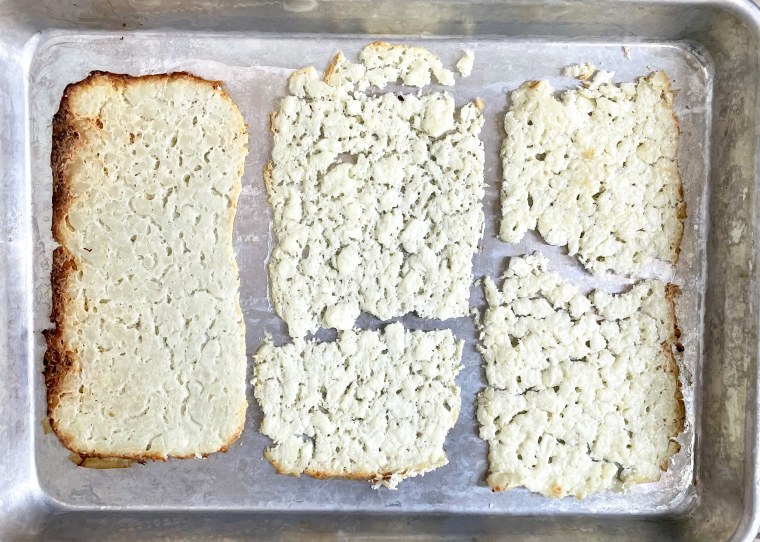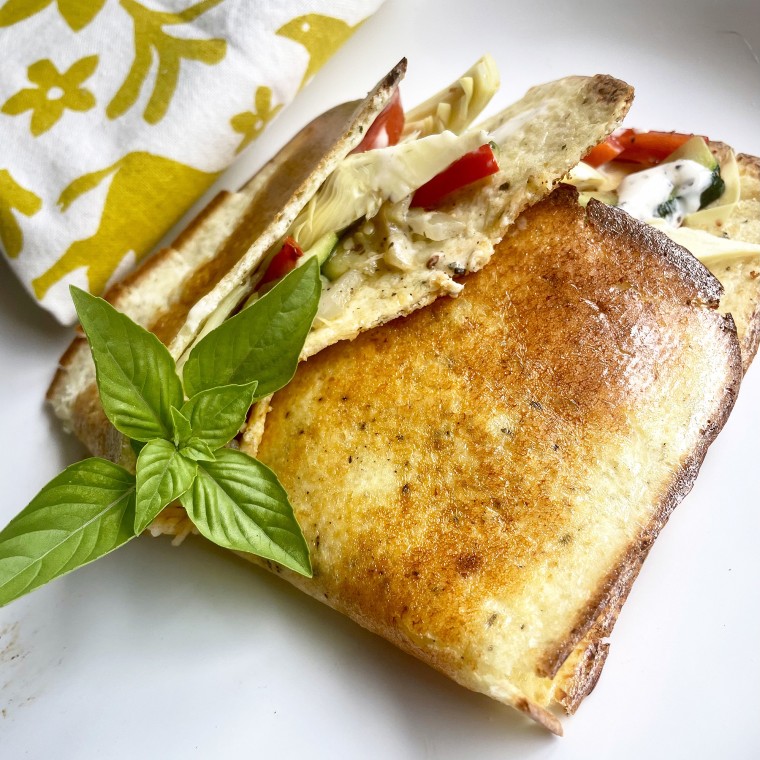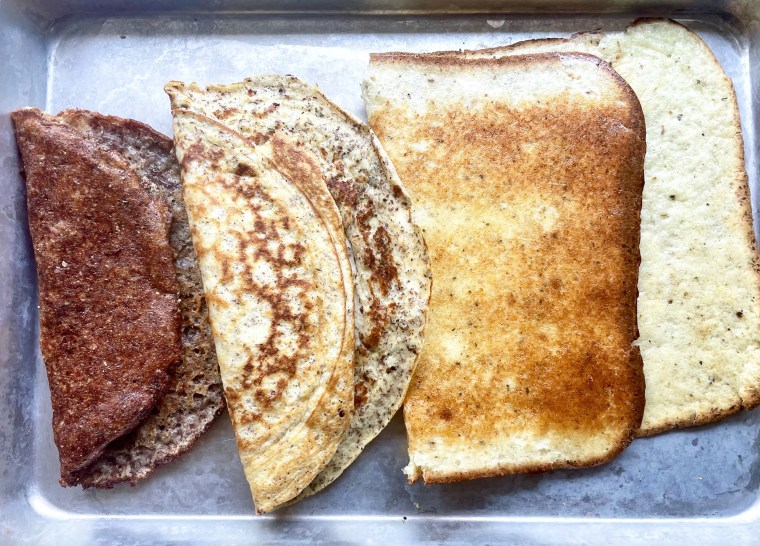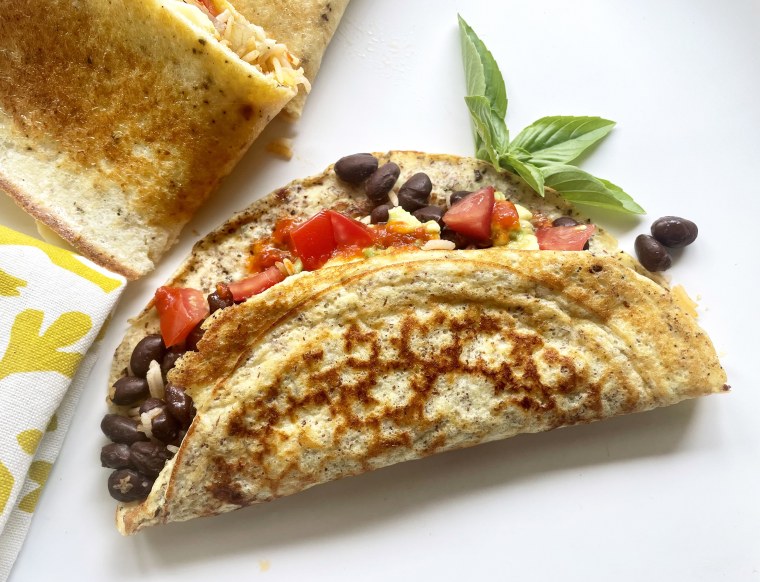Cottage cheese is in its diet hack heyday and shows no signs of slowing down. I’ve tried cottage cheese ice cream (thumbs up), cottage cheese scrambled eggs (thumbs down), and even something dubbed the cottage cheese and mustard diet (thumbs — it depends), and that’s just the beginning. The latest TikTok darling? A cottage cheese wrap.
I think I have watched every single one of these videos, and there are thousands. Edited into sound bites, it could not look easier. But is that the reality?
Some are single-ingredient recipes — cottage cheese right out of the container, baked in a flatbread shape. But, most versions are more complicated, using cottage cheese blended with egg or egg white. A few are air fried or cooked quickly in a skillet. Some are flash-baked at over 400 degrees, but most allegedly delicious recipes cook at 350 F for 40 minutes. There’s even a tortilla version!
TikToker Capri Lilly (@goodfoodbaddie) has some promising tips for success: using a high-protein cottage cheese, blending for just 30 seconds, shaping as you pour and choosing a moderate baking temperature. Her high-protein sammie certainly looks scrumptious.
But after watching so many of these videos, I was left wondering, “What’s up with the modern cottage cheese obsession, anyway? Is it really healthy? Is it even cheese?”
According to the National Historic Cheesemaking Center, the public’s infatuation might go back to ancient Egypt and Greece, when storing milk in animal stomachs naturally led to a soupy curdle — mmmm! While the food has been available in home kitchens for thousands of years, it’s been commercially produced in the U.S. since the 1860s.
In the 1950s, cottage cheese was an appetite-suppressing staple, along with cigarettes and amphetamines. It’s a thrifty source of complete protein, and saw a rise while folks were rationing meat during World War I — just look at this cottage cheese “roast” made with lima beans and pimentos.
Now, the hype around cottage cheese wraps is high, though the comments are mixed, ranging from enthusiastic approval to cheerful skepticism and even outright hatred.
The results of taste tests are mixed, too. A lot of testers complain of eggy an taste, holes and tears in the wrap, or the dreaded patches of scorched cracker alternating with flabby goo.
But I had some potential tricks up my sleeve that I wanted to take for a test drive!

Does it matter what kind of cottage cheese mixture you use?
I was curious about whether the exact kind of cottage cheese makes a difference in how the wrap comes out. A lot of reviewers report good results with small curd varieties, especially a brand called Good Culture. I tested that brand along with 2% and 4% milk fat store brands and the differences were pretty obvious.
The wrap made with Good Culture (smallest curd size and a high protein content) was the only one that held together at all. It even passed the critical sandwich fold test — the other two failed miserably.
It tasted good, but the texture was a bit tough, similar to the crispy cheese around a pizza’s edge. It really did have to bake for 40 minutes to be anywhere near done. On the plus side, it could not be easier to prep and there were minimal dishes to do afterward.

The egg versions shown online look a lot more conducive to wrapping, hinting at a more pliable texture. Most use a ratio of 2-to-one cottage cheese to egg.
I tried Lilly’s tips, blending 1 cup of cottage cheese with two eggs, garlic and spices before baking at 350 F for 40 minutes — it worked like a charm. The wrap came off the pan in one piece and was both soft enough to fold and sturdy enough to hold. I used room temperature eggs to minimize any potential eggy flavor.
I’m still frustrated by how long I had to have my oven going to make this version, though. Plus, since it requires blending, this recipe leaves a lot more to be cleaned up.
Luckily, Mediterranean vegetables with tomato and yogurt sauce made me forget those troubles in a heartbeat. I demolished the wrap standing up in my kitchen; partly because it was excellent, and partly because I was starving after that ludicrously interminable baking time.

Then I tried the cottage-cheese-only version again, this time with some adjustments. My goal was to improve cohesion and shorten the cook time. I also tried blending the store brand, which made me think curd size would make less of a difference.
After the delectable success of past viral food hacks like pickles in a cheese blanket and feta fried eggs, and taking inspiration from the cottage cheese tortilla, I was optimistic that I could make a cottage cheese-only version in a skillet.
Knowing that ground flax makes a passable egg substitute in a baking pinch, I added 2 teaspoons of the powdered seeds to hopefully raise my chances of it holding together. There was an alarming bubbly liquid phase in the middle, but it ultimately did work.
Cooking took less than 10 minutes on the stove top, and the cheese tortilla held together. However, much like the other cottage-cheese only attempts, it had a tougher, almost plastic-like texture.
Still, it tasted good and boasted some fiber and omega-3 fatty acids from the flax.

Next, I tried a half batch of Lilly’s batter recipe in a skillet sprayed with oil on the stovetop. I found it was impossible to flip without tearing.
Instead, I found using equal amounts of cottage cheese and egg, plus 2 teaspoons of ground flax, to be a real winner. The store brand of cottage cheese worked just fine here. I flipped once, and it took only 5 minutes. I chose a bean, rice and avocado filling for a truly delicious, balanced, nutritious breakfast with just one carb serving and more than 20 grams of protein.
What’s the verdict on these cottage cheese wraps?
Like the comments, my opinions are mixed.
It can be fussy, energy intensive, and a little bit pricey once you count up the ingredients.
Keep in mind that the best studied human diets for health include a moderate amount of carbohydrates. As a dietitian, I’m always looking for whole grains and high-fiber foods, so a whole grain wrap is one way to incorporate those components into your diet. Even if you don’t always choose whole wheat, it’s perfectly okay to use tortillas, pita, lavash and other flatbreads for wraps and tacos.
But, if you have special dietary needs like food allergies, or you’d like to balance out a high carb or low protein wrap filling, using this gluten-free, mostly protein exterior might make sense.
If you want to assess the hype for yourself, allow yourself some room to practice, regardless of the method. From my experience, I can tell you that warped pans and oven hotspots are a recipe for disaster. Nonstick helpers like parchment, silicone mats and teflon coatings are critical, and binders like higher protein cottage cheese, egg and ground flax can help keep the fillings in the wrap instead of on the floor. Seasonings will take it over the top, but one half-cup serving of cottage cheese contains over 350 milligrams of sodium, so there’s no need to add more.
And, whatever you do, don’t fold the wrap more than once. Stick to a taco or folded flatbread shape — attempting a burrito roll might make your breakfast a real bust.
"food recipes" - Google News
June 08, 2024 at 01:45AM
https://ift.tt/SX7aGkx
Viral Cottage Cheese Wrap Review - TODAY
"food recipes" - Google News
https://ift.tt/7Qfl6r8
https://ift.tt/HpiLzY8
Bagikan Berita Ini















0 Response to "Viral Cottage Cheese Wrap Review - TODAY"
Post a Comment